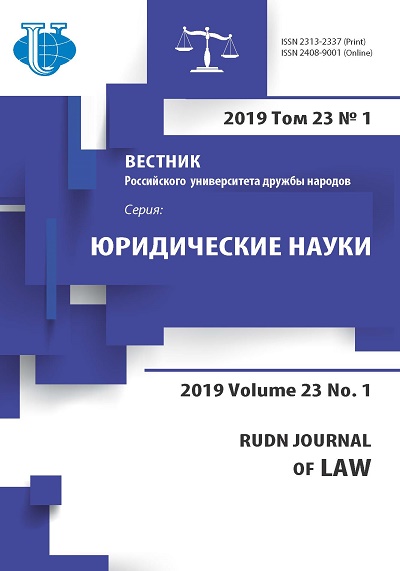THE ANTI-TERRORIST FUNCTION OF THE RUSSIAN STATE: THE CONCEPT AND THE BASIC SIGNS
- Authors: Mits D.S1
-
Affiliations:
- Parliamentary Assembly of the Collective Security Treaty Organization
- Issue: Vol 23, No 1 (2019)
- Pages: 27-47
- Section: STATE AND LAW IN CONTEMPORARY WORLD
- URL: https://journals.rudn.ru/law/article/view/21173
- DOI: https://doi.org/10.22363/2313-2337-2019-23-1-27-47
- ID: 21173
Cite item
Full Text
Abstract
The article compares the important organizational and legal trends and prospects of antiterrorist activity, as well as the associated conceptual apparatus and the essence of terrorism. In the theory of criminal law, terrorism is defined as a threat to public security, in contrast to other areas of knowledge. This criminal phenomenon is implemented through the impact on a third party to the conflict (primarily ordinary citizens), that is, to encourage them to transform the foundations of statehood. In this regard, the system of management of information counteraction to terrorism, extremist activity and other forms of encroachment on the constitutional system, as well as other spheres of state functioning is gaining momentum.
About the authors
Denis S Mits
Parliamentary Assembly of the Collective Security Treaty Organization
Author for correspondence.
Email: a-83@bk.ru
Candidate of Legal Science, expert Advisory Board of the Council of the Parliamentary Assembly of the Collective Security Treaty (CSTO)
47, Shpalernaya, St. Petersburg, Russia, 191015References
- Arce, D.G. (2018) On the human consequences of terrorism // Public Choise. Pp. 429-446. (in English)
- Alexander, Y., Carlton, D., Wilkinson P. (eds.) (1979) Terrorism: Theory & Practice. Published in cooperation with the Institute for Studies in International Terrorism. Boulder, CO: Westview Press. 15. (in English).
- Denisov, A.I. (1960) Sushchnost' i formy gosudarstva [The essence and form of the state]. Moscow., Pр. 9-10. (in Russian).
- Il'in, E.P. (2010) O nekotoryh aspektah formirovaniya edinogo mezhdunarodnogo antiterroristicheskogo kogo prostranstva [On some aspects of the formation of a single international antiterrorist space] // Vestnik Nacional'nogo antiterroristicheskogo komiteta [Bulletin of the National Anti-Terrorism Committee]. 1 (01). 68-69. (in Russian)
- Kask, L.I. (1969) Funkcii i struktura gosudarstva [Functions and structure of the state]. Leningrad. Pp. 8-11. (in Russian).
- Kelsen, H. (1952) Principles of Intenational Law. N.Y. Pp. 208. (in English).
- Kelsen, H. (1961) General Theory of Law and State. N.Y. Pp. 181. (in English).
- Letschert, R., Staiger I., Pemberton A. (2010) Assisting Victims of Terrorism: Towards a European Standard of Justice. Dordrecht, Haidelberg London New York: Springer Science and Business Media. Pp. 347. (in English).
- Luna, E., Wade, M. (2012) The Prosecutor in Transnational Perspective. Oxford: Oxford University Press. Pp. 471. (in English).
- Marchenko, M.N. (2016) Teoriya gosudarstva i prava: uchebnik [Theory of State and Law: a textbook]. - 2-e izd., pererab. i dop. [second edition revised and updated] - Moscow: Prospekt [Prospect]. Pp. 640. (in Russian).
- Marchenko, M.N. (ed.) (2001) Obshchaya teoriya gosudarstva i prava: Akademicheskij kurs [General Theory of State and Law: Academic Course]: V 3 t. T 1. 2-e izd. [second edition] Moscow. Pp. 336-353. (in Russian).
- McClean, D. (2002) International Cooperation in Civil and Criminal Matters. Oxford: Oxford University Press. Pp. 458. (in English).
- Miettinen, S. (2013) Criminal Law and Policy in the European Union. London and New York: Routledge. Pp. 248. (in English).
- Mitsilegas, V. (2009) EU Criminal Law. Portland: Hart Publishing. Pp. 352. (in English)
- Morozova, L.A. (1993) Funkcii Rossijskogo gosudarstva na sovremennom ehtape [Functions of the Russian state at the present stage] // Gosudarstvo i pravo [State and law]. (6). 98-108. (in Russian).
- Muller-Graff, P. (2009) Der Raum der Freiheit, der Sicherheit und des Rechts in der Lissaboner Reform. EuR Beiheft 1. Pp.105. (in German).
- Newburn, T. (2003) Crime and Criminal Justice. 2nd ed.Essex: Pearson education Limited. Pp. 313. (in English).
- O'Keefe, D. (1995) Recasting the Third Pillar // Common Market Law Review. (32). Pp. 893-920. (in English).
- Peers, S., Hervey, T., Kenner, J., Ward, A. (2014) The EU Charter of fundamental rights. A commentary. Oxford: Hart Publishing. Pp. 1825. (in English)
- Persak, N. (2014) Legitimacy and Trust in Criminal Law, Policy and Justice: Norms, Procedures. Dorchester: Dorset Press. Pp. 200.
- Piris, J.C. (2006) The Constitution for Europe: A Legal Analysis. Cambridge: Cambridge University Press. Pp. 292.
- Pradel, J., Corstens, J. (2002) Droit penal europeen. Paris: Dalloz. Pp. 609. (in Franch)
- Rad'ko, T.N., Lazarev V.V., Morozova L.A. (2016) Teoriya gosudarstva i prava [Theory of State and Law]: uchebnik dlya bakalavrov [textbook for bachelors]. Moscow: Prospekt [Prospect]. Pp. 568. (in Russian).
- Tumanov, S.N. (2017) Mekhanizm realizacii vneshnih funkcij Rossijskogo gosudarstva (voprosy teorii i praktiki) [Mechanism for the implementation of external functions of the Russian state (theory and practice)]: avtoreferat diss. … dok. yurid. nauk [dissertation of the doctor of legal sciences]. Penza. Pp. 27-35. (in Russian).
- Vengerov, A.B. (ed.) (1994) Teoriya gosudarstva i prava [Theory of State and Law]. Vyp. 2. M. Pp. 40. (in Russian).
Supplementary files















